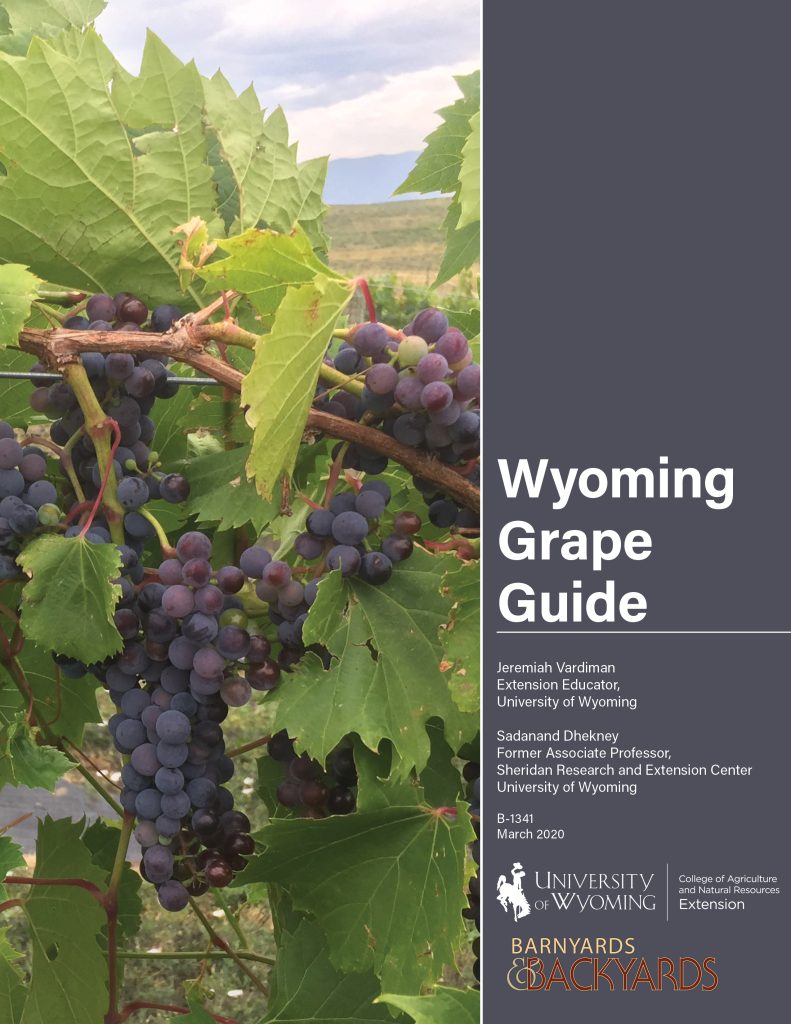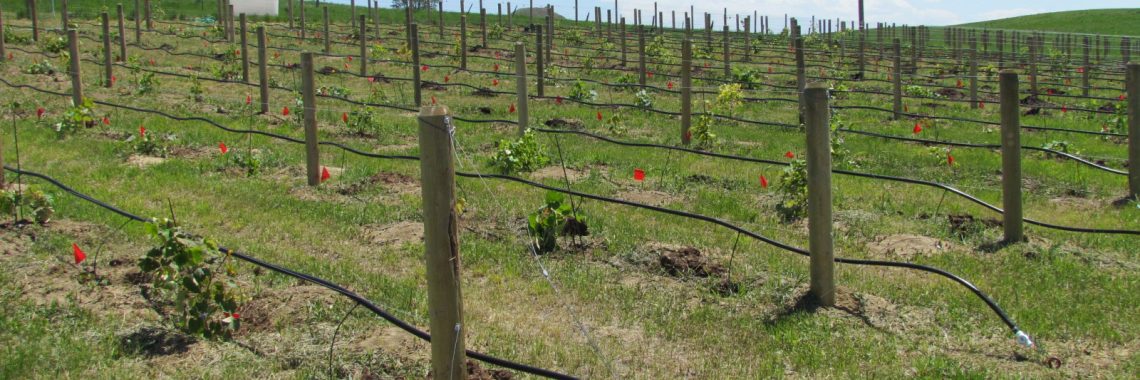New grapevines need the greatest number of frost free growing days possible for establishment and success in Wyoming’s climate.
Spring is the best time of year to plant grapevines, but Wyoming springs can be deceiving and unpredictable.
Planting the vines too early can subject them to late spring freezes, which can kill them.
Planting grapevines is ideal when the chance of a late freeze is low, 10 percent or less. Cheyenne, for example, has the earliest planting date on the table of May 26. Of course, there are many springs when March and April warm up and have minimal freezes. Do not be fooled by these conditions because Wyoming can still have a few freezes before June.
Vine care and preparation
If possible, order vines so they will be delivered two or three days prior to when you want to plant. Two to three days allow plenty of time for vines to warm and fully hydrate prior to planting. This is easily accomplished by placing the vines in a bucket of room temperature water that is an inch past the crown of the plant. The plants should be stored in a room 50 degrees Fahrenheit or warmer.
The buckets do not need to be placed in sunlight or under grow lights. The vines can be kept in these buckets for up to a week or so if planting is delayed. They should be potted and placed in an area with sunlight if planting does not occur within 10 days of delivery.
Vines can also be potted and grown in a greenhouse or grow house prior to planting. This method provides an extra month or more of growth for the year. The more robust the vines, the better their chances of establishing and surviving winter.
Potted vines should have their root ball broken apart prior to planting and all j‑hooks or circling roots pruned for straight growth habit. Vines that have been grown in a pot need hardened off prior to planting by placing them outside starting with a couple hours a day and extending the time over a two‑week period. This allows the vine to acclimate to the wind, humidity, and temperatures it will be growing in. Hardening off should only happen on days with average weather patterns, not extreme wind, moisture, cold or freezing temps, or excessively dry conditions.
Spring Date for a 10% chance of freeze (32°)
Afton — July 19
Casper — June 8
Cheyenne — May 26
Cody — June 1
Evanston — July 11
Laramie — June 25
Riverton — June 18
Rock Springs — June 13
Sheridan — June 18
Sundance — June 16
Planting
Holes should be deep and wide enough to accept all the roots, without curling or bending them. The hole should be wide enough to spread the roots out as far as possible. Backfill the hole with loose soil while holding the plant in place. The proper planting depth is to the crown of the plant, where the roots flare out from the trunk, barely below the soil surface. Should compost be added to the hole before planting? There tends to be two working theories. The first is this is Wyoming and plants that grow here need to be tough, so if grapes are going to thrive here, they will need to grow in the native soil in which they are planted. The second theory is that adding compost can provide the strongest and healthiest vines, which will aid in getting them established, even though the vine will grow into the native soil as it matures.
If compost is used, add prior to or at the time of planting and then mix no more than two parts native soil and one part compost. Just for clarification, compost is not manure.
Always call One Call of Wyoming (811) before digging.
Vine care
Water newly planted vines as soon as possible. Stake each vine with a robust grow stake for support. Bamboo stakes can work for the first two or three years. Smaller diameter stakes tend to break under the weight of vines once they start maturing. Grow tubes can also be used to provide optimal growing conditions for vines. Grow tubes protect the vines from wind, provide warmer temperatures, and slightly increase humidity. Grow tubes can be placed after planting; however, they should be removed in late summer or early fall allowing the vines to prepare for winter dormancy.
Training a straight and strong vine is part of the establishment period. Grapevines need support and training to accomplish the desired t‑structure, which is formed by the trunk and the cordons of the vine (Figure 1). Cordons are the “arms” of the grapevine where leaves and grapes are produced. The vine should be tied to the stake to create an erect and strong trunk as the vine grows over the next several years. The ties should be tight enough to hold the vine to the stake or trellis but loose enough the vine is not girdled from the tie as it grows (Figure 2). These ties are loosened or removed and retied multiple times a growing season.
For the first growing season, the goal is to grow the vine to the top wire of the trellis system (5 or 6 feet tall). All shoots are tied up to encourage a straight and erect growth habit; very little if any pruning is done because the more vegetation on the vine means more photosynthesis (food) for a larger and healthier vine. Remove all flowers this first year to push all energy reserves into the vine’s growth and development. Ensure the trunk is tied as straight as possible, especially directly prior to the vine setting wood, which occurs during the fall.


Year 2
For the second growing season, if the vine dies back to the ground, repeat the first year’s training method until growth is maintained on the stake. If the vine is healthy and growing on the stake, then prune the vine that will become the trunk directly above the node that is at or slightly above the trellis wire. Nodes are growth points on a branch where a new branch will form. As the vine starts to grow, train the two shoots that are on opposite sides of each other and closest to the top wire to grow along the trellis wire to create the cordons. Prune all suckers that are growing from the base of the vine and remove all flowers to push all nutrients into growth of the vine. Make sure to adjust or retie the trunk and cordons as needed. Maintaining as straight of a trunk and cordons as possible benefits future production.
Year 3
For the third growing season, if everything has gone perfectly and the vine has survived on the trellis, count the number of nodes per cordon. The vine will need to be terminated after a desired number of nodes. The number desired is dependent on the variety grown and spacing within the vineyard. Typically, there are 12 to 20 nodes per cordon. Faster growing varieties are pruned to the lower node count while slower growing varieties are pruned at the higher node count. The cordon termination should also end near the next vine’s cordon, which maximizes the space on the trellis, creating a solid curtain of vegetation and fruit production. Flowers can be kept for fruit production if the t‑structure is obtained by this year. All suckers should be removed, along with any vegetative growth (leaves, vines, flowers) on the trunk.
Establishing and maintaining a t‑structure for grapevines is best for health and longevity of a vine, which also provides the highest yield potential. The t‑structure starts the first year with correctly planting healthy vines that can maximize the first growing season.
More articles about establishing vineyards and other related information is at www.barnyardsandbackyards.com.
Jeremiah Vardiman is Wyoming’s Grape Man. He is a University of Wyoming Extension educator in Park County serving northwestern Wyoming. He can be reached at (307) 754-8836 or at jvardima@uwyo.edu.







